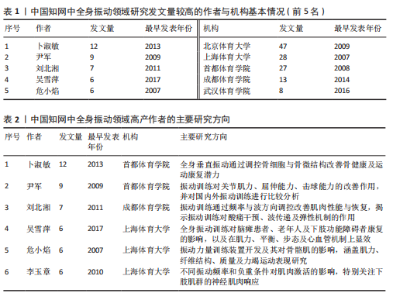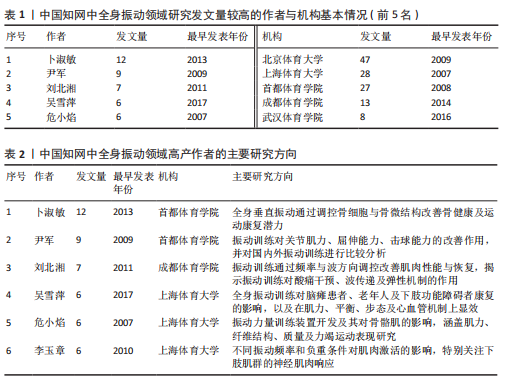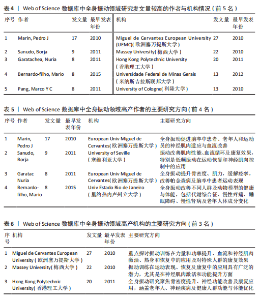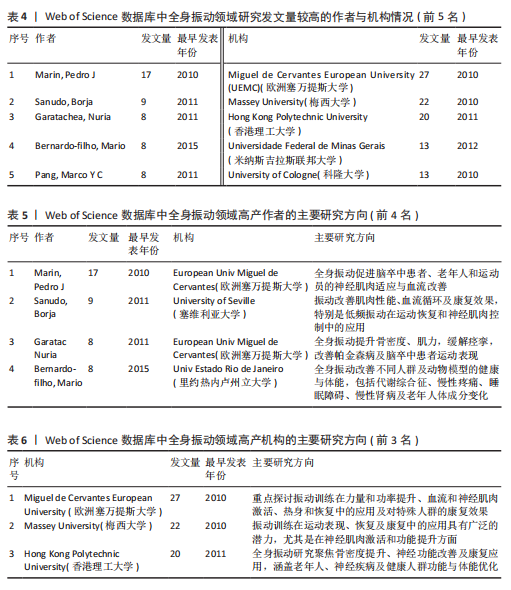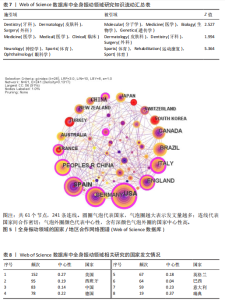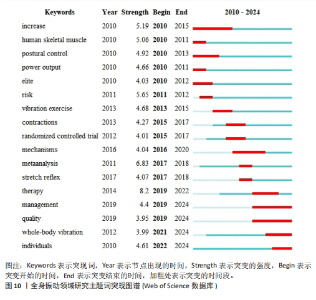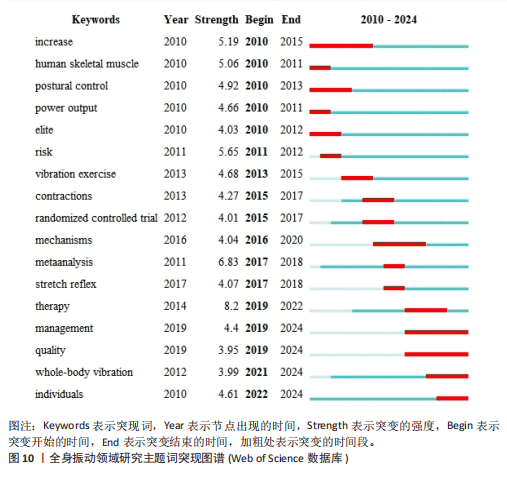Chinese Journal of Tissue Engineering Research ›› 2026, Vol. 30 ›› Issue (11): 2896-2908.doi: 10.12307/2026.062
Previous Articles Next Articles
Visualization analysis of whole-body vibration training: research progress, hotspots, and future trends
Xiao Meina, Jiang Chuanyin
- School of Martial Arts, Shanghai University of Sport, Shanghai 200438, China
-
Received:2025-03-10Accepted:2025-05-06Online:2026-04-18Published:2025-09-10 -
Contact:Jiang Chuanyin, Professor, School of Martial Arts, Shanghai University of Sport, Shanghai 200438, China -
About author:Xiao Meina, MS, School of Martial Arts, Shanghai University of Sport, Shanghai 200438, China
CLC Number:
Cite this article
Xiao Meina, Jiang Chuanyin. Visualization analysis of whole-body vibration training: research progress, hotspots, and future trends[J]. Chinese Journal of Tissue Engineering Research, 2026, 30(11): 2896-2908.
share this article
Add to citation manager EndNote|Reference Manager|ProCite|BibTeX|RefWorks
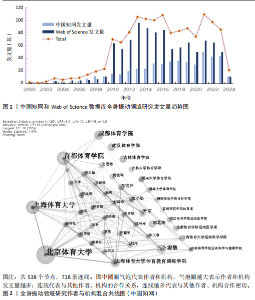
2.1 全身振动领域文献发展脉络分析 2.1.1 发文量分析 共纳入661篇中文文献和1 005篇英文文献。由图1可见,Web of Science数据库中的全身振动相关文献略高于中国知网数据库,并呈逻辑曲线增长。全身振动领域发文量整体来看主要分为3个阶段,初期缓慢增长阶段(2000-2010年),全身振动领域相关的发文量较低,国内外的研究数量都相对较少,发文趋势较为平缓,尚未形成较大的研究热潮;快速发展阶段(2011-2018年),国内外全身振动领域总的发文曲线呈波浪式增长趋势,说明国内外对全身振动研究关注度保持较好的趋势,形成对全身振动领域相关研究热潮的高峰期;稳定发展阶段(2019-2024年),全身振动领域的发文量增长趋势明显放缓,发文数量趋于稳定,整体呈现出波动性的变化。国内外的发文数量比例趋于平稳,尽管国外的发文量仍然占据较大比重,但增速放缓,表明该领域的研究热度有所下降,可能是前期基础性研究处于较为饱和状态。 2.1.2 国内外全身振动研究相关作者与机构情况 (1)中国知网数据库中全身振动领域主要作者机构研究情况:全身振动相关研究的作者与机构混合共线图能够较好地反映该领域的作者与研究机构之间的关系[7]。国内各研究机构和作者之间已形成相对密切的合作网络,但仍存在个别联系密度不足的情况(图2),机构与作者之间的合作关系仍需进一步加强,以促进知识和资源的共享,推动全身振动领域的研究和发展。国内全身振动领域研究发文量较高的作者与机构基本情况(前5名),见表1。为获取高产作者机构关于全身振动领域研究的方向,对高中心性作者和机构相关文章进行研读,见表2,3。 从作者与机构混合共现图谱和表格可以看出,国内全身振动研究的主阵地是体育院校,以北京体育大学、上海体育大学、首都体育学院3大体育学院为首,发文量排在前3位的学者是卜淑敏、尹军、刘北湘,高中心性作者机构之间是相互联系的,学术上的交流相对较频繁。国内高产作者与机构主要关注全身振动对运动表现和康复应用的提升,尤其是针对特定人群的肌肉力量、关节健康和骨密度等生理机制的研究。国内关于全身振动领域相关研究热点问题更侧重于振"

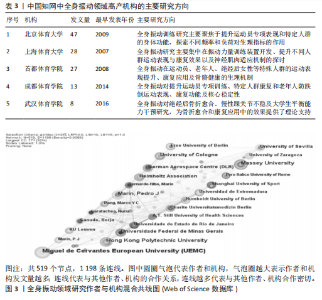
动训练在竞技运动员及老年人、绝经后女性等人群中的效果,通过试验探索全身振动对肌力、平衡能力和骨骼健康的影响;以及通过应用动态对比模型对气动加载自激振动力量训练器的开发研制[8],探索不同振动参数对运动表现和康复功能的作用。 (2) Web of Science数据库中全身振动领域主要作者机构研究情况:从作者与机构混合共现图谱(图3)和表格(表4)可以看出,发文量排名前3的是Marin, Pedro J、Sanudo, Borja、Pang, Marco Y C;排名前3的机构为Miguel de Cervantes European University (UEMC)(欧洲塞万提斯大学)、Massey University(梅西大学)、Hong Kong Polytechnic University (香港理工大学);高中心性作者机构之间是相互联系的,学术上的交流相对较频繁。国外高产作者与机构更加广泛地研究全身振动对神经肌肉功能和身体整体健康的改善,应用于更广泛的疾病康复和健康管理中, Web of Science数据库中关于全身振动领域研究热点问题则更侧重全身振动对中枢神经系统疾病(如脑卒中、帕金森病)患者的康复、代谢综合征和慢性病患者的生活质量提升,特别关注全身振动对血流速度、神经肌肉适应、体脂变化和骨密度的系统性影响[9],更注重全身振动在广泛人群和多样化健康状况下的干预效果,为全身振动在康复医学和健康促进中的应用提供支持。 为获取 Web of Science数据库中高产作者机构关于全身振动研究的方向,对高中心性作者和机构的相关文章进行研读,汇总见表5,6。 总的来看,国内作者机构研究更具实用导向,强调振动训练在运动员和老年人等群体中的应用效果,国外作者机构研究更具广泛性和系统性,侧重于全身振动对不同健康人群的全身性康复和健康改善的长期作用。 2.1.3 学科间知识流动 双图叠加功能是将一幅CiteSpace图谱叠加到另一幅图谱之上,前者称为叠加图,后者称为底图。双图叠加本质就是施引域与被引域之间的联系,通过叠加图可以反映学科之间在期刊层面的知识流动[10]。通过双图叠加可以发现Web of Science数据库中国外全身振动领域的研究主要分布在哪些期刊并由哪些期刊所引用,从而揭示Web of Science数据库中国外全身振动期刊"
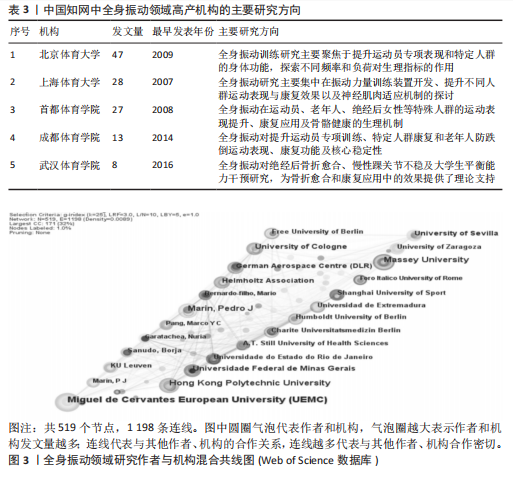
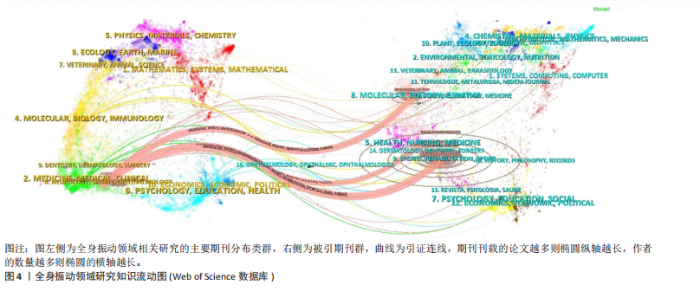
知识流动的态势。通过不同颜色区分不同地区期刊来源,轨迹的厚度与Z值呈正比。 如图4所示,图左侧指Web of Science数据库中全身振动研究的主要期刊分布类群,右边是被引期刊群,曲线为引证连线,完整地展示了引用的来龙去脉,在左侧图中,期刊刊载的论文越多则椭圆纵轴越长,作者的数量越多则椭圆的横轴越长。结合表7可以得到全身振动领域的研究主要集中于物理、材料、动物科学、数学、系统、生物学、免疫学、牙科、皮肤病学、外科医学、医学、临床神经病学、运动、眼科、心理学、教育学等。对全身振动研究的引用集中在康复、材料、物理、兽医学、动物、计算机技术、生物学、遗传学、健康、护理、医学、皮肤病学、牙科、外科运动、运动史、哲学、心理学等。其中,在临床神经学、体育、眼科这个类群作为来源期刊时,对应的被引期刊体育、康复、运动这个类群有最高的引用量,Z值最高,为5.364,因此,国外相关全身振动领域研究期刊大量集中于医学和体育运动。通过CiteSpace的双图叠加,从知识交流角度来看,Web of Science数据库中全身振动领域知识流的变化主要从牙科、内外科医学、流向分子、医学、生物学和从神经病学、运动、眼科流向了体育、康复、运动期刊类群,为全身振动领域研究的拓展提供新的研究范式。 通过对 Web of Science 数据库中国外全身振动领域多角度的可视化研究,揭示Web of Science数据库中全身振动领域知识流的发展动态和新兴趋势,对中国在该领域中的研究与发展提供借鉴,有利于促进中国全身振动领域知识流研究的创新与发展。 2.1.4 全身振动领域研究相关国家地区情况 运用CiteSpace软件生成国际全身振动领域的国家/地区合作共线图谱(图5)。图中每个节点代表不同的国家,节点的大小表示频次出现的高低,圆环最外层表示中心性,中心性为整个网络图谱连接其他节点的枢纽[11]。从图5和表8可以看出,瑞典"
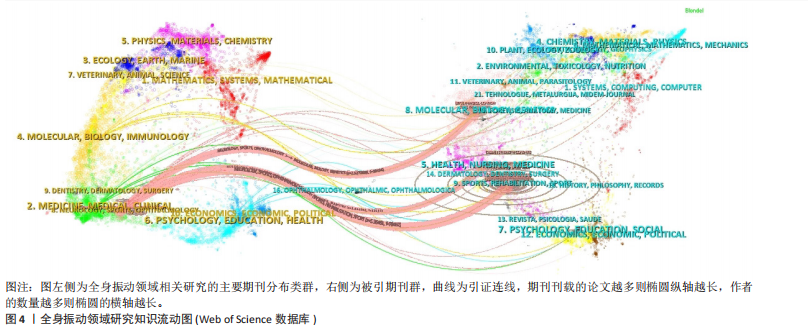
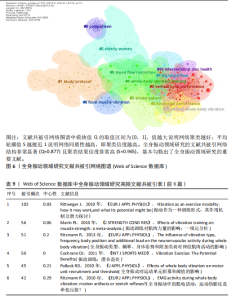
的中心性最高(0.37),美国(0.27)、意大利(0.23)、德国(0.22)、西班牙(0.19)分列2-5位,中国的中心性为0.14排名第8。中心性排名前5的4个国家都来自欧洲,说明欧洲在全身振动领域的研究具有举足轻重的影响力。在短时间内发表大量相关全身振动领域研究的国家主要有西班牙(6.33)、韩国(4.24)、比利时(3.31)、土耳其(3.23)、法国(3.16)5个国家。图形以不同颜色深度的圆圈标示,其中圆环的大小与该国发文量呈正相关,节点之间的连线表示国家之间的合作关系,连线颜色和粗细表示合作开始时间和合作强度,从中可以看出对全身振动领域研究各国之间的连线相对紧密。 通过对相关文献梳理发现这些文献共分布于61个国家和地区,来自中亚、东南亚、非洲和中美洲的研究相对较少,这也说明全身振动研究的科研水平与经济发展水平息息相关。参与全身振动研究的国家数量总体呈现逐年递增趋势,美国以152篇的发文量占据首位,西班牙(95篇)、中国(83篇)、德国(78篇)、英国(67篇)、巴西(64篇)、意大利(59篇)、加拿大(55篇)依次排列,其余国家均未突破50篇(表8)。中国从1981年就关注全身振动研究领域[12],发文量居前3,但国际合作参与度还不够,应继续加强国际合作,以提高我国在全身振动这一研究领域的国际地位。 2.2 研究热点及变化趋势 2.2.1 文献共被引分析 文献共被引分析是指2篇文献共同出现在第三篇施引文献的参考文献中,则这2篇文献形成共被引的关系,可以反映某一研究领域的知识结构组成[13]。通过文献共被引分析,可以明确 Web of Science 数据库全身振动领域研究的研究方向和热点主题,进而能够对该学科领域的研究有客观准确的认识。全身振动领域研究主要形成11个聚类,#0 Vertical jump performance(垂直跳跃性能)包含118篇被引文献,#1 Study protocol(研究方案)包含87篇文献,#2 Functional performance(功能表现)包含75篇文献,#3 Stroke patient(脑卒中患者)包含70篇文献,#4 Whole-body vibration training(全身振动训练)包含78篇文献,#5 Blood flow restriction(血流限制)包含67篇文献,#6 Elderly women(老年妇女)包含50篇文献,#7 Leg blood flow(腿部血流)包含36篇文献,#8 Focal muscle vibration(局部肌肉振动)包含23篇文献,#9 Comparison(对照)包含19篇文献,#10Intervertebral disc herniation(椎间盘突出症)包12篇文献,#12 Adding whole body vibration(增加全身振动)包含7篇文献,不同聚类采用不同颜色代表不同文献研究板块(图6)。由此可见,以上几个方面为全身振动领域大多数研究者共同关注的话题。 共被引文献代表全身振动领域的知识基础,根据被引频次高低整理被引突现文献中的经典施引文献作为分析的数据源,可以综合判断和探测新兴趋势。表9汇总全身振动领域研究经典高被引文献,其中被引频次最高的是Rittweger J(2010年)发表的《Vibration as an exercise modality: how it may work,and what its potential might be》[14],该文献被引用102次,系统综述了全身振动作为运动形式的生理机制及其在运动与医学中的应用潜力。然而,尽管全身振动的多重益处得到了肯定,其相对"
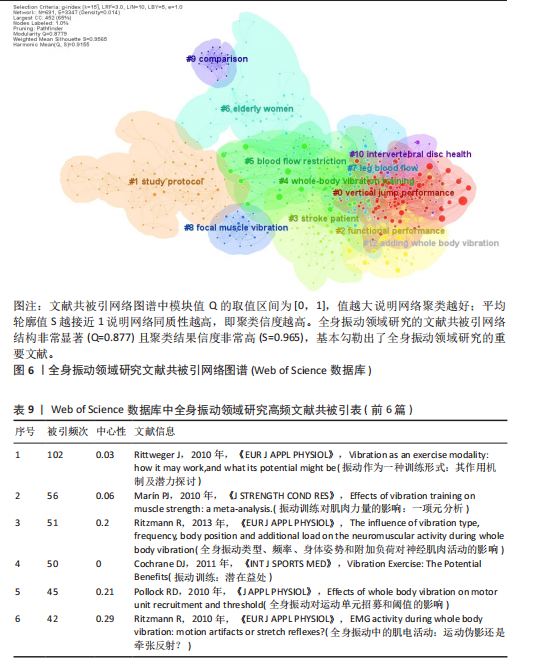
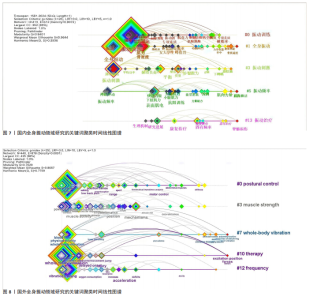
于传统阻力训练的优势尚不明确,未来仍需进一步研究以优化其应用方法和安全标准。其次是Marín PJ(2010年)的《Effects of vibration training on muscle strength: a meta-analysis》[15],通过对31项研究的元分析发现,垂直振动平台在增强肌肉力量方面对未训练人群和老年人效果更显著,并且女性力量提升幅度大于男性。频次第三的是Ritzmann R(2013年)的《The influence of vibration type, frequency, body position and additional load on the neuromuscular activity during whole body vibration》[16], 对18名受试者的研究发现,侧向交替振动、较高频率、较大膝关节弯曲角度和附加负荷能显著激活神经肌肉活动。频次第四的是Cochrane DJ(2011年)的《Vibration Exercise: The Potential Benefits》[17],综述了振动训练能显著提升肌肉力量和爆发力,尤其适用于运动员和老年人,但对心血管功能影响有限,并且最佳训练参数仍需进一步探索。频次第五的是Pollock RD(2012年)的《Effects of whole body vibration on motor unit recruitment and threshold》[18],发现全身振动通过改变运动单位的招募阈值改善肌肉功能,但不同类型的运动单位对振动的响应不同,需进一步探讨其长期效果。其中,中心性最显著的被引文献是Ritzmann R(2010年)的《EMG activity during whole body vibration: motion artifacts or stretch reflexes?》[19],研究分析10名受试者在不同振动频率下的肌电图信号,验证了肌电信号主要由牵张反射引发,而运动伪影的影响微乎其微,这一发现为全身振动在运动训练和康复中的应用提供了科学理论依据。 全身振动领域的高被引文献主要以综述性和实验应用为主,当前研究趋势主要集中在个性化参数优化、神经肌肉长期适应、特殊人群康复应用、新型设备创新和多学科交叉研究,以推动全身振动在运动训练与康复中的广泛应用。 2.2.2 关键词聚类时间线图 关键词的时区分布是按照聚类类型,将不同聚类中的关键词按照首次出现的时间从远到近的顺序排列,从而显现每个关键词聚类的发展历程,能够清晰地展示时间维度上全身振动领域的演进过程[20]。如图7和图8所示,国内外全身振动领域研究形成的关键词聚类时间线图中,均有5种聚类一直是热点关键词,国内全身振动领域形成的关键词聚类为#0 振动训练、#1 全身振动、#3振动刺激、#5振动频率、#13振动治疗;国外全身振动领域形成的关键词聚类为#0 postural control(姿势控制)、#3 muscle strength(肌肉力量)、#7 whole body vibration(全身振动)、#10 therapy(治疗)、#12 frequency(频率)。 (1)国内全身振动领域研究关键词聚类时间线图 振动训练对专项素质的影响:#0振动训练(2006-2023年)。振动训练对包括武术、球类运动和田径等竞技专项运动素质的研究集中于提升运动表现与关节保护等方面。杜文娅等[21]发现45 Hz振动刺激对于改善"
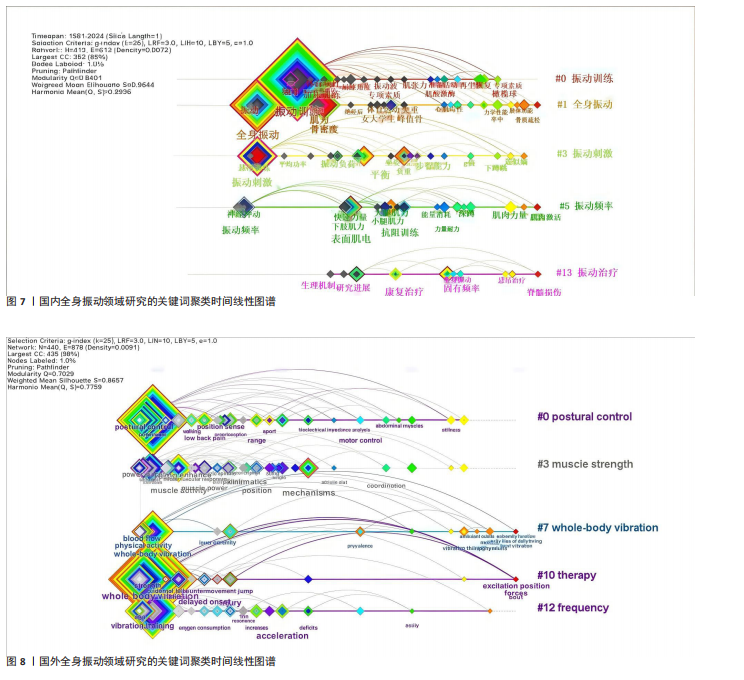
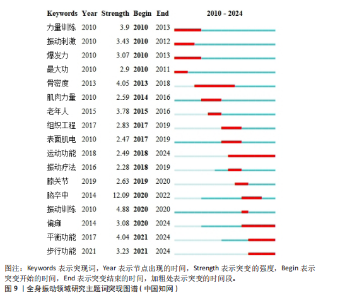
排球运动员力量和平衡能力效果优于 30 Hz。齐千榕等[22]发现50 Hz频率对短道速滑运动员膝关节最大力量和快速力量的提升方面显著优于30 Hz频率。余宏等[23]发现振动训练能够显著提高大学生足球运动员的膝关节屈、伸肌的最大力量、爆发力和肌肉耐力。全身振动训练在关节保护和功能性提升方面也显示出积极效果。林长地等[24]研究发现24周的高频振动训练可显著增强老年女性的动、静态平衡能力,在关节保护和功能性恢复方面表现出良好效果。总体而言,振动训练不仅有效提升了运动员的专项运动素质,还在关节保护和运动表现多方面改善中展现出重要的应用价值,为各类竞技项目提供了具有潜力的训练方法。 全身振动在不同领域中的应用:#1全身振动(2003-2024年)。全身振动作为一种新型有效的训练方法,已广泛应用于竞技体育、大众健身、康复医学、美容医学以及航天医学等多个领域。在训练学领域,通过合理设计振动参数,全身振动能够显著提升肌肉力量和运动表现,对能量消耗和应激激素调节也有潜在影响,已成为运动训练领域的研究热点[25];在康复医学方面,全身振动疗法对神经系统、骨关节系统和肌肉系统疾病均具有良好的康复效果,能够提高肌肉力量、改善运动功能恢复、促进骨折愈合等,因其操作简便和效果可靠被广泛作为临床辅助治疗手段[26]。尤其在老年人群中,全身振动在肌肉-骨骼系统退行性疾病的康复中展现出独特优势,能够改善骨质疏松、增强肌肉力量、提升平衡及步态功能,对代谢综合征、骨关节炎和肌少症等问题的康复有显著作用[27];此外,全身振动在特定人群中的功能性康复与症状管理中也具有成效。如在绝经后女性中,低强度的全身振动有助于提升骨密度、预防骨质疏松[28];对于慢性疾病的患者,如脑卒中、2型糖尿病、高血压及帕金森病等,全身振动能够有效增强神经肌肉功能、改善平衡能力和步行功能[29];对于肥胖人群,全身振动通过促使脂肪细胞膜破裂或促使脂肪细胞内的脂滴水解,有助于快速减少脂肪厚度[30]。综上所述,全身振动作为一种多功能的辅助训练手段,已在多个领域展现出广泛的应用潜力和显著的效果,未来有望在基础研究和临床应用中得到进一步发展和完善。 振动刺激结合负重对步行与爆发力的影响:#3振动刺激(2002-2024年)。振动刺激结合抗阻训练能够有效提高下肢肌肉的激活水平,在步行和爆发力等运动表现方面具有显著效果。蒋子豪等[31]研究发现,股四头肌离心训练结合50 Hz振动刺激可以显著改善髌腱末端病患者股四头肌力量、肌耐力和股内侧肌激活率,同时降低膝关节疼痛并提高膝关节功能。另外,不同振动频率与负重组合在下肢肌肉激活效果上也表现出差异性,袁旗俊[32]研究发现,30 Hz频率结合75%最大重复值的负重训练有助于下肢肌肉间的协调发展;袁艳等[33]发现在半蹲训练中增加50 Hz振动刺激能显著增加大腿肌肉激活水平,并在进一步研究中发现当振动参数为2 mm振幅、50 Hz频率结合30%最大重复值负重时,半蹲训练可有效提升快速力量和神经适应性,具体表现为H反射潜伏期、最大波高/最大转矩比值的降低以及姿势稳定指数的增强[34]。总体而言,振动刺激结合负重训练为提升运动表现和康复效果提供了一种新视角,为下肢肌肉力量、神经适应性及协调发展提供了有效支持。 不同振动频率对肌肉激活和功能恢复的急性效应:#5振动频率(2002-2024年)。不同频率的振动对肌肉表现和功能恢复方面具有显著性差异。欧阳秀雄等[35]研究发现,30 Hz和50 Hz的振动频率均能在5 min内显著增加皮肤血流量,其中50 Hz组的升高更显著,表明50 Hz相较于30 Hz在增强循环功能具有更好效果。张帆等[36]发现不同频率振动对肌肉激活具有差异性,高频低振幅和中频中振幅能够降低α运动神经元的兴奋性,而低频高振幅可增加γ反射弧的兴奋性。刘或秀等[37]的研究表明,与单纯抗阻训练(0 Hz)相比,30 Hz和40 Hz的振动结合抗阻训练能够显著提高中老年女性下肢主要肌群的肌肉激活效果。另外,不同振动频率对关节功能的恢复也有积极影响。黄鹏等[38]发现在屈膝45°条件下,高频(45 Hz)振动比中低频(30 Hz)振动在提升膝关节本体感觉方面效果更为显著。振动频率与振幅的选择对不同训练目标和康复需求具有显著影响,而如何建立相对完善有效的全身振动训练理论体系、制定具体的理想振动参数来指导临床疾病的康复治疗,仍需要大样本试验来进一步深入研究和探索[25]。 振动治疗在损伤康复中的作用机制:#13振动治疗(2017-2024年)。全身振动治疗的主要机制在于改善神经系统调节,通过振动刺激肌梭、腱梭等本体感受器引起肌肉长度的快速变化,从而诱发受神经支配的骨骼肌的牵张反射以增强其神经肌肉的功能,通过激活拮抗肌的Ia抑制神经元抑制拮抗肌的兴奋性,从而增强肢体活动的灵活性和协调性[38]。振动训练除了在力量、爆发力、姿势控制、平衡和骨密度上有积极的作用外,它作为准备活动和再生恢复手段也有着明显的积极效果,特别是振动训练结合静态拉伸时对机体影响效果更加显著[40]。张新强等[41]研究发现,采用低振幅、低振动频率和短时间的局部脉冲振动刺激治疗可加快促进兔前交叉韧带重建术后本体感受器恢复。振动治疗还广泛应用于神经系统康复,三维旋进式振动疗法联合常规康复训练应用于脑卒中偏瘫患者可有效改善患者的上下肢痉挛状态、提高步行能力和生活质量[42]。在延迟性肌肉酸痛方面,振动泡沫轴联合静态拉伸训练能够缓解高强度离心运动后疼痛,改善运动表现,加速延迟性肌肉酸痛恢复,降低血液肌酸激酶水平,对组织微损伤的修复及炎症反应的缓解也具有促进作用[43]。振动疗法联合悬吊训练可显著改善前交叉韧带重建患者的膝关节功能,增加肌肉力量和对称性,提高平衡与稳定性[44]。综上所述,振动治疗通过多重机制对神经肌肉系统和本体感觉产生显著的改善作用,被广泛应用于力量提升、运动恢复及功能性康复中,展现出良好的临床潜力和应用前景。 (2)国外全身振动领域研究关键词聚类时间线图 姿势控制对运动表现及稳定性的影响:#0 postural control(2010-2022年)。机械振动通过姿势控制策略、肌肉张力调节机制及神经反射途径可显著增强神经肌肉功能。全身振动训练能有效提高骨矿物质密度、耐力、力量,显著增强本体感觉系统。POLLOCK 等[45]发现在膝盖上方的振动频率高于15 Hz的振动条件下,加速度会随着与平台距离的增加而逐渐减弱,这种现象可能与姿势控制及肌肉激活机制的提升密切相关。 ASAHINA等[46]发现通过机械振动会引起肌肉的持续收缩,可有效改善老年血液透析患者平衡和步态能力。CHELHO-OLIVEIRA等[47]在一项Meta分析中指出,全身振动对患有慢性踝关节不稳或功能性踝关节不稳的运动员具有积极作用,能够提升其神经肌肉性能和肌肉力量,从而增强平衡能力和姿势控制。上述研究结果表明,全身振动在姿势控制方面的优化作用不仅有助于提升运动表现,对运动后的稳定性和功能恢复同样至关重要。总体而言,姿势控制的改善对于提升运动表现、支持稳定性和促进运动后的功能恢复具有显著应用价值。 振动训练对肌肉力量的适应性效应:#3 muscle strength(2010-2023年)。振动训练在老年人和特定疾病患者人群的肌肉力量训练中表现出显著的适应性效应,尽管部分研究未能观察到显著的力量提升,但总体趋势表明全身振动结合传统力量训练可有效提高下肢肌肉的力量与耐力。LAI等[48]发现深蹲训练结合全身振动能够有效提升膝骨关节炎患者的身体功能和肌肉力量。XIONG等[49]在一项为期16周每周进行3次、每次约15 min的全身振动和150 mmHg局部加压干预试验中,发现与单一干预相比,全身振动联合加压训练对老年女性下肢关节肌力具有积极影响。XIAO等[50]进一步表明全身振动能够显著改善膝关节力量、平衡力、步行速度耐力、骨密度和姿势控制,是改善老年人下肢肌肉力量和身体表现的有效干预措施。这些研究共同表明全身振动在增强肌肉力量和功能方面展现出良好潜力,特别适用于骨关节炎、脑瘫及其他慢性疾病患者的康复和功能改善,具有明显的适应性效果。 全身振动对力量、柔韧性及神经肌肉活动的综合影响:#7 whole body vibration(2010-2024年)。全身振动作为一种神经肌肉训练法,能够改善肌肉力量、爆发力和柔韧性,作用效果受到振幅、频率范围、振动类型、应用方法、训练强度、运动方案及参与者特征等多种因素的影响[51]。ARORA等[52]发现全身振动作为辅助训练方式能够增强股内侧斜肌的神经肌肉活动,结合阻力训练的全身振动对足部和踝部肌群有持久影响,能够改变外侧腓肠肌和股内斜肌的活动水平与力量,显著提高运动员的爆发力表现。PUJARI等[53]研究振动参数与肌肉收缩水平的组合对全身振动刺激下等长运动神经肌肉反应的影响,发现50 Hz、0.5 mm的振动刺激能够诱导最大的神经肌肉活动;同样地,WU等[54]的研究建议在运动员热身阶段使用全身振动,以提高神经肌肉力量和爆发力。 振动治疗对肌肉表现和疲劳的恢复作用:#10 Therapy(2012-2023年)。全身振动作为一项潜在的治疗方式,能够有效改善非特异性慢性腰痛患者的疼痛、残疾、平衡、本体感觉、功能表现和生活质量[55]。全身振动联合传统物理治疗不仅能有效提升老年人腿部肌肉力量,还可改善脑瘫儿童和帕金森病患者的关节位置感、平衡能力和步态功能。LEABEATER等[56]通过肌肉按摩枪对软组织进行有针对性振动,发现可有效增加关节活动范围并减少肌肉酸痛,对机体知觉恢复和运动后表现的恢复具有积极影响。PAMUKOFF等[57]研究指出,全身和局部振动能够为膝关节病变患者恢复股四头肌力量提供积极作用。另外,振动疗法已被证实对缓解延迟性肌肉酸痛具有积极作用,成为一种行之有效的物理治疗手段。AKEHURST等[58]研究发现,振动疗法通过减少炎症和提高神经肌肉效率能够有效减轻疼痛和僵硬,对预防和治疗延迟性肌肉酸痛表现出潜在效果。振动治疗在癌症患者中也具有应用潜力,如LOPES-SOUZA等[59]对患有乳腺癌、肺癌、前列腺癌及其他类型实体癌或血液癌患者进行振动干预研究,发现全身振动在抵消癌症治疗相关症状方面具有一定效果。尽管全身振动被视为癌症治疗相关病症的潜在辅助治疗手段,但针对不同疾病阶段的具体方案仍需进一步研究。 不同频率对神经肌肉协调机制的作用:#12 Frequency(2010-2023年)。不同频率的全身振动对神经肌肉协调影响显现出多样化的激活效果。PETIT等[60]进行不同频率和峰值位移设置的6周全身振动训练对膝伸肌力量和爆发力研究,发现高频/高峰峰值位移设置在增强膝伸肌力量和跳跃表现方面的效果最佳。在康复应用中,LIAO等[61]探讨不同强度全身振动训练对脑卒中患者在动态运动中下肢肌肉神经肌肉激活的影响,发现高强度全身振动(30 Hz,1.61 g)比低强度全身振动(20 Hz,0.96 g)更能显著增加患侧肢体的腓肠肌和股二头肌的激活程度。在运动训练中,CHUNG等[62]比较了相同加速度下不同频率和振幅组合的8周全身振动训练对膝伸肌力量和爆发力的影响,发现高频低振幅组合显著提升等长收缩力量和120 (°)/s等速向心收缩力量;中频中振幅组合显著增加60 (°)/s和120 (°)/s向心与离心等速收缩强度;低频高振幅组合在60 (°)/s和120 (°)/s等速离心收缩力量方面的提升尤为显著,表明不同频率与振幅组合可以有针对性地提升特定的神经肌肉反应,从而适应不同的运动需求。MAO等[63]发现高频率(30 Hz)振动结合高强度(80%最大静力收缩)的抗阻训练可显著提高肌电活动,而低强度(40%最大静力收缩)结合低频率(10,20 Hz)振动训练可显著增加氧气消耗,表明高频振动更有利于增强肌肉活动,而低频振动可能更适用于耐力或有氧需求的训练目标。POJSKIC等[64]发现不同频率的全身振动(25 Hz和50 Hz)对空手道运动员垂直跳跃变化表现在整体影响上并不显著,而且高频(50 Hz)结合负载时表现出最差的纵跳表现,表明高频振动在负载条件下可能会增加神经肌肉负担,对部分运动员的表现产生负面影响。因此,频率选择应根据个体需求和训练目标谨慎调整,以便优化神经肌肉协调效果。 综上所述,国内外对全身振动训练的研究各有侧重,国内研究更关注全身振动在竞技运动、康复医学和健身中的应用效果,尤其关注不同振动频率对力量、平衡和爆发力的影响,并积极探索在竞技和康复中的实际应用效果;同时,国内对特定人群如老年人、运动员等的康复效果及专项训练效果进行了深入探讨。相较之下,国外研究更多关注全身振动对神经肌肉系统、姿势控制、肌肉协调机制等基础理论的影响,通过详细的实验探讨全身振动的不同频率、振幅组合对肌肉适应性、平衡和功能恢复的机制;此外,国外还在特殊人群如慢性病、老年和癌症患者中开展全身振动的临床应用,探索其潜在的康复价值。总体而言,国内研究更偏重于应用效果的探索,而国外研究则更加注重全身振动对神经肌肉系统的适应性和协调机制的多样化激活作用的系统性研究。 2.2.3 关键词突现图 为深入探讨国内外全身振动研究领域知识结构的演化规律,对关键词进行突现分析可以进一步地了解全身振动领域的前沿热点变化和发展趋势。此次研究利用CiteSpace软件提供的突现词探测技术,通过考察词频的时间分布,能揭示出主题词中频次变化率较高关键词的突变强度和持续时间,依靠词频的变动趋势来确定国内外全身振动领域研究的发展趋势[65]。通过CiteSpace生成的关键词突现图可以系统梳理出全身振动研究在不同阶段的知识结构框架,深入探讨其发展脉络的整体轮廓。分别对国内外全身振动研究领域的关键词进行突变监测结果,均得到17个突现词。 (1)国内全身振动领域研究主题词突现图:如图9所示,国内全身振动领域主题词突现分为3个时间段:①2010-2014年:国内研究主要集中在肌肉运动表现领域,关注力量训练、振动刺激、爆发力、最大功、骨密度、肌肉力量等关键词,表明这一时期全身振动的应用主要用于提高肌肉力量和运动表现。②2015-2018年:研究内容逐渐扩展至振动疗法,并开始关注老年群体的应用,出现老年人、组织工程、表面肌电、运动功能、振动疗法等突现词,反映了全身振动在健康促进和康复方面的广泛应用。特别是运动功能成为2018年到至今的热点关键词,说明全身振动在运动功能恢复中的应用得到持续关注。③2019-2021年:国内全身振动研究进一步关注临床应用,关键词如膝关节、脑卒中、振动训练、偏瘫、平衡功能和步行功能的突现,显示全身振动在康复领域的应用,尤其对平衡与步态功能恢复、脑卒中后偏瘫患者的治疗。 (2)国外全身振动领域研究主题词突现图:如图10所示,国外全身振动领域主题词突现分为3个时间段:①2010-2011年:国外全身振动研究主要探讨应用效果和潜在风险,突现词包括增长、骨骼肌、姿势控制、功率输出、精英、风险等,表明国外对全身振动应用可能带来的风险和益处持谨慎态度,并在精英运动员和骨骼健康方面进行了初步探讨;②2013-2016年:研究重点逐步转向随机对照试验来验证全身振动的效果,突现词有振动训练、痉挛、随机对照实验、机械装置,反映出国外重视科学严谨的试验设计,以确保全身振动的有效性和安全性;③2017-2022年:国外在全身振动领域的研究采用元分析方法系统整合现有研究成果,突现词包括元分析、牵张反射、治疗、特征、全身振动、个体,显示了国外对全身振动疗效的系统评价和"
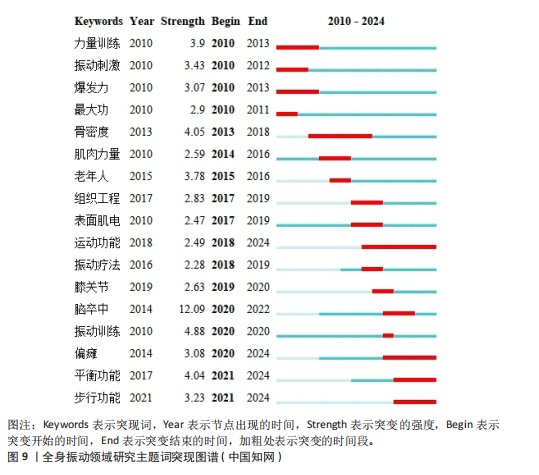
| [1] 孙长良,何敏学,解超.振动力量训练对我国运动员髋关节最大肌力干预效果的Meta分析[J].沈阳体育学院学报, 2017,36(5):82-87. [2] DE SOUZA HCM, PESSOA MF, DOS SANTOS CLEMENTE R, et al. Inspiratory muscle training in addition to whole body vibration for functional and physical outcomes in pre-frail older women: a randomized controlled trial. Age Ageing. 2022;51(4):afac083. [3] LAU RW, LIAO LR, YU F, et al. The effects of whole body vibration therapy on bone mineral density and leg muscle strength in older adults: a systematic review and meta-analysis. Clin Rehabil. 2011;25(11):975-988. [4] LIANG V, HENDERSON G, WU J. Neuromuscular response to a single session of whole-body vibration in children with cerebral palsy: A pilot study. Clin Biomech (Bristol). 2020;80:105170. [5] 陈悦,陈超美,刘则渊,等.CiteSpace知识图谱的方法论功能[J].科学学研究, 2015,33(2): 242-253. [6] CHEN Y, CHEN M, LIUZY, et al. The methodology function of Cite Space mapping knowledge domains. Studies in Science of Science. 2015;1(10):3-5. [7] CHEN C. CiteSpace II: Detecting and visualizing emerging trends and transient patterns in scientific literature. J Am Soc Inf Sci Technol. 2006;57(3):359-377. [8] 李晓浦.自激振动力量训练器的研制以及气动与振动加载力量训练在某些生物学力学指标上差别的探研[D].上海:上海体育学院,2008. [9] FATEH HR, NAKHOSTIN ANSARI N, NAKHOSTIN-ANSARI A, et al. The effects of local calf vibration on balance, blood flow, and nerve conductivity in patients with diabetic peripheral neuropathy: a pilot study. Physiother Theory Pract. 2024; 40(7):1397-1403. [10] ZHU YJ, KIM MC, CHEN CM. An investigation of the intellectual structure of opinion mining research. Information Research. 2017;22(1):1. [11] FANG J, PAN L, GU QX, et al. Scientometric analysis of mTOR signaling pathway in liver disease. Ann Transl Med. 2020;8(4):93. [12] 李昌吉.不同强度的全身低频振动长期作用对大白鼠的影响[J].卫生专业参考资料,1981(2):44. [13] LI J, GOERLANDT F, RENIERS G. Mapping process safety: A retrospective scientometric analysis of three process safety related journals (1999–2018). J Loss Prev Process Ind. 2020;65:104141. [14] RITTWEGER J. Vibration as an exercise modality: how it may work, and what its potential might be. Eur J Appl Physiol. 2010; 108(5):877-904. [15] MARFN PJ, RHEA MR. Effects of vibration training on muscle strength: a meta-analysis. J Strength Cond Res. 2010;24(2):548-56. [16] RITZMANN R, GOLLHOFER A, KRAMER A. The influence of vibration type, frequency, body position and additional load on the neuromuscular activity during whole body vibration. Eur J Appl Physiol. 2013;113(1):1-11. [17] COCHRANE DJ. Vibration exercise: the potential benefits. Int J Sports Med. 2011; 32(2):75-99. [18] POLLOCK RD, WOLEDGE RC, MARTIN FC, et al. Effects of whole body vibration on motor unit recruitment and threshold. J Appl Physiol. 2012;112(3):388-395. [19] RITZMANN R, KRAMER A, GRUBER M, et al. EMG activity during whole body vibration: motion artifacts or stretch reflexes? Eur J Appl Physiol. 2010;110(1):143-151. [20] CAS J. Science Mapping:A Systematic Review of the Literature. JDIS. 2017; 2(2):1-40. [21] 杜文娅,孙越颖,高峰,等.不同频率振动刺激对排球运动员力量及平衡能力影响的实验研究[J]. 成都体育学院学报, 2017,43(6):103-108. [22] 齐千榕,王新.不同频率振动训练对短道速滑学生下肢肌力的影响研究[J].医用生物力学,2024,39(S1):168. [23] 余宏,刘琰.振动训练足球运动者膝关节屈伸肌群肌肉的力量[J].中国组织工程研究,2019,23(15):2327-2331. [24] 林长地,程亮,林晞.全身振动训练对老年女性平衡能力和下肢关节肌力的影响[J].首都体育学院学报,2015,27(6):572-576. [25] 卜淑敏,韩天雨.全身振动训练在运动训练和康复领域中的应用及研究进展[J].北京体育大学学报,2014,27(8):65-70. [26] 伍丹丹,严隽陶.振动疗法在康复临床中的应用及研究进展[J].现代中西医结合杂志,2020,29(4):452-456. [27] 张丽,瓮长水.全身振动训练在老年康复领域应用的研究进展[J].中国康复理论与实践,2015(2):163-167. [28] 李汇明.低强度全身振动与绝经后骨质疏松症[J].生物医学工程学杂志,2018, 35(2):301-306, 313. [29] 谭景旺,吴雪萍.全身振动训练对老年人下肢功能和慢性疾病影响的研究与进展[J].中国组织工程研究,2017,21(8):1288-1293. [30] 谢嘉平,任力锋,黄穗红,等.振动减肥中腹壁脂肪的超声检测与力学特征[J].中国医学物理学杂志,1996(4):213-216. [31] 蒋子豪,王广兰,陈鹏,等.离心训练结合不同频率全身振动训练治疗髌腱末端病[J].中国组织工程研究,2024,28(4):493-498. [32] 袁旗俊.振动刺激与抗阻训练干预普通大学生下肢肌力的效果研究[D].成都: 成都体育学院,2019. [33] 袁艳,吴贻刚,苏彦炬,等.振动频率和负荷重量对半蹲起大腿肌群表面肌电活动的影响[J].体育科学,2012,32(10):64-68,封3. [34] 袁艳,苏彦炬,吴贻刚.负重振动训练对下肢快速力量的影响及其神经适应的特征[J].北京体育大学学报,2016,39(11):62-67. [35] 欧阳秀雄,湛超军.振动训练同振幅不同频率与振动时间对血流量变化的研究[J].北京体育大学学报,2008,31(7):929-931. [36] 张帆,王竹影,蒋琴华,等.相同g值强度时不同振幅与频率模式对下肢神经肌肉表现的影响[J]. 中国体育科技, 2021,57(11): 59-66,73. [37] 刘彧秀,陈晓红.中老年女性不同半蹲模式振动抗阻训练下肢肌肉及躯干肌肉的激活特征比较[J]. 首都体育学院学报, 2023,35(1):68-76. [38] 黄鹏,王安利.不同频率振动训练对膝关节位置觉影响的实验研究[J].北京体育大学学报, 2012,35(11):40-45. [39] 史智君,严隽陶,孔亚敏.振动疗法在康复中的应用及其影响因素[J].中国医学物理学杂志, 2019,36(1):102-107. [40] 许华文,扆铮,汪煜雄,等.振动训练在准备活动与再生恢复中作用的研究进展[J].山东体育科技, 2021,43(4):51-55. [41] 张新强,王博,冯会成.局部脉冲振动刺激对兔前交叉韧带重建后本体感觉恢复的影响[J].吉林大学学报(医学版),2023, 49(6):1407-1414. [42] 赵敏, 杨娜娜, 沈筠筠, 等. 三维旋进式振动疗法联合常规康复训练对脑卒中偏瘫患者上下肢痉挛状态、步行能力及生活质量的影响[J]. 现代生物医学进展, 2023,23(20):3960-3963. [43] 刘立佳.振动泡沐轴联合静态拉伸对延迟性肌肉酸痛运动表现的研究[D].武汉:武汉体育学院,2024. [44] 陈文汉,门杰,杨伟,等.振动疗法联合悬吊训练前交叉韧带重建后患者运动及膝关节功能的变化[J].中国组织工程研究,2024,29(11):2225-2230. [45] POLLOCK RD, WOLEDGE RC, MILLS K, et al. Muscle activity and acceleration during whole body vibration:Effect of frequency and amplitude. Clin Biomech. 2010;25(8):840-846. [46] ASAHINA Y, SAKAGUCHI Y, KAJIMOTO S, et al. A Randomized Controlled Trial of Whole-Body Vibration on Gait Ability and Balance among Older Hemodialysis Patients. Clin J Am Soc Nephrol. 2023; 18(1):84-90. [47] COELHO-OLIVEIRA AC, TAIAR R, PESSANHA-FREITAS J, et al. Effects of Whole-Body Vibration Exercise on Athletes with Ankle Instability: A Systematic Review. Int J Environ Res Public Health. 2023; 20(5):4522. [48] LAI Z, LEE S, HU X, et al. Effect of adding whole-body vibration training to squat training on physical function and muscle strength in individuals with knee osteoarthritis. J Musculoskelet Neuronal Interact. 2019;19:333-341. [49] XIONG W, LIU X. Effects of whole-body vibration training combined with KAATSU training on lower limb joint muscle strength in older women.Front Physiol. 2023;14:1231088. [50] TAN X, JIANG G, ZHANG L, et al. Effects of Whole-Body Vibration Training on Lower Limb Muscle Strength and Physical Performance Among Older Adults: A Systematic Review and Meta-analysis. Arch Phys Med Rehabil. 2023;104(11): 1954-1965. [51] ALAM M M, KHAN AA, FAROOQ MO. Effect of whole-body vibration on neuromuscular performance: A literature review. Work. 2018;59(4):571-583. [52] ARORA NK, SHARMA S, SAIFI S, et al. Effects of combined whole body vibration and resistance training on lower quadrants electromyographic activity, muscle strength and power in athletes. Foot. 2021; 49:101844. [53] PUJARI AN, NEILSON RD, CARDINALE M. Effects of different vibration frequencies, amplitudes and contraction levels on lower limb muscles during graded isometric contractions superimposed on whole body vibration stimulation. J Rehabil Assist Technol Eng. 2019;6(2055-6683): 1107261594. [54] WU C, WANG M, CHANG C, et al. The acute effects of whole body vibration stimulus warm-up on skill-related physical capabilities in volleyball players. Sci Rep. 2021;11(1):5606. [55] ZAFAR T, ZAKI S, ALAM MF, et al. Effect of Whole-Body Vibration Exercise on Pain, Disability, Balance, Proprioception, Functional Performance and Quality of Life in People with Non-Specific Chronic Low Back Pain: A Systematic Review and Meta-Analysis. J Clin Med. 2024;13(6):1639. [56] LEABEATER A, CLARKE AC, JAMES LP, et al. Under the Gun: Percussive Massage Therapy and Physical and Perceptual Recovery in Active Adults. J Athl Train. 2024;59(3):310-316. [57] PAMUKOFF DN, PIETROSIMONE B, LEWEK MD, et al. Whole-Body and Local Muscle Vibration Immediately Improve Quadriceps Function in Individuals With Anterior Cruciate Ligament Reconstruction. Arch Phys Med Rehabil. 2016;97(7):1121-1129. [58] AKEHURST H, GRICE J, ANGIOI M, et al. Whole-body vibration decreases delayed onset muscle soreness following eccentric exercise in elite hockey players: a randomised controlled trial. J Orthop Surg Res. 2021;16(1):589. [59] LOPES-SOUZA P, DIONELLO CDF, DE SÁ-CAPUTO DDC, et al. Whole body vibration exercise in the management of cancer therapy-related morbidities: A systematic review. Drug Discov Ther. 2018;12(4):239-247. [60] PETIT P, PENSINI M, TESSARO J, et al. Optimal whole-body vibration settings for muscle strength and power enhancement in human knee extensors. J Electromyogr Kinesiol. 2010;20(1050-6411):1186-1195. [61] LIAO L, PANG MYC. Effect of Whole-Body Vibration on Neuromuscular Activation of Leg Muscles During Dynamic Exercises in Individuals With Stroke. J Strength Cond Res. 2017;31(7):1954-1962. [62] CHUNG P, LIU C, WANG H, et al. Various performance-enhancing effects from the same intensity of whole-body vibration training. J Sport Health Sci. 2017;6(3):333-339. [63] MAO T Y, CHEN H, LEE S, et al. Effects of Vibration Resistance Exercises on EMG and Skeletal Muscle Hemodynamics. Am J Health Behav. 2022;46(3):274-284. [64] POJSKIĆ H, ZOMBRA Ž, WASHIF JA, et al. Acute Effects of Loaded and Unloaded Whole-Body Vibration on Vertical Jump Performance in Karate Athletes. J Hum Kinet. 2023;92:203-212. [65] CHEN C, DUBIN R, KIM MC. Emerging trends and new developments in regenerative medicine: a scientometric update (2000-2014). Expert Opin Biol Ther. 2014;14(9):1295-1317. |
| [1] | Cao Xinyan, Yu Zifu, Leng Xiaoxuan, Gao Shiai, Chen Jinhui, Liu Xihua. Effect of repetitive transcranial magnetic stimulation and transcranial direct current stimulation on motor function and gait in children with cerebral palsy: a network meta-analysis [J]. Chinese Journal of Tissue Engineering Research, 2026, 30(6): 1539-1548. |
| [2] | Huang Jie, Zeng Hao, Wang Wenchi, Lyu Zhucheng, Cui Wei. Visualization analysis of literature on the effect of lipid metabolism on osteoporosis [J]. Chinese Journal of Tissue Engineering Research, 2026, 30(6): 1558-1568. |
| [3] | Chen Qiang, Wu Wenjuan, Jiang Shuhua, Huang Da. Physical exercise improves physical function in burn patients: a systematic review and meta-analysis [J]. Chinese Journal of Tissue Engineering Research, 2026, 30(5): 1269-1281. |
| [4] | Zhou Jian, Zhang Tao, Zhou Weili, Zhao Xingcheng, Wang Jun, Shen Jie, Qian Li, Lu Ming. Effects of resistance training on quadriceps mass and knee joint function in patients with osteoporosis and sarcopenia [J]. Chinese Journal of Tissue Engineering Research, 2026, 30(5): 1081-1088. |
| [5] | Liao Guangtao, Feng Ziyu, Fu Xiaoyong, Zhao Qinglan, Chen Chao, Hong Jinsong. Subtalar arthroereisis for treatment of pediatric flexible flatfoot: relationship between radiographic indicators and clinical efficacy [J]. Chinese Journal of Tissue Engineering Research, 2026, 30(3): 661-670. |
| [6] | Peng Hao, Chen Qigang, Shen Zhen. A visual analysis of research hotspots of H-type vessels in various bone diseases [J]. Chinese Journal of Tissue Engineering Research, 2026, 30(3): 760-769. |
| [7] | Ren Pengbo, Li Tingwen, Cai Feng, Zhang Jian. Meta-analysis of lumbar bone mineral density, pain score and fall incidence in middle-aged and elderly osteoporosis patients undergoing whole-body vibration training [J]. Chinese Journal of Tissue Engineering Research, 2026, 30(10): 2569-2575. |
| [8] | Hu Yujie, Xie Ping, , Lu Weijie, Yang Kang, Deng Yaoting, Liu Mengyang. Meta-analysis of the clinical efficacy of high-intensity interval exercise and middle-intensity continuous training in patients with coronary heart disease [J]. Chinese Journal of Tissue Engineering Research, 2026, 30(10): 2584-2593. |
| [9] | Liang Haobo, Wang Zeyu, Ma Wenlong, Liu Hao, Liu Youwen. Hot issues in the field of joint revision: infection, rehabilitation nursing, bone defect, and prosthesis loosening [J]. Chinese Journal of Tissue Engineering Research, 2025, 29(9): 1963-1971. |
| [10] | Xie Liugang, Cui Shuke, Guo Nannan, Li Aoyu, Zhang Jingrui. Research hotspots and frontiers of stem cells for Alzheimer’s disease [J]. Chinese Journal of Tissue Engineering Research, 2025, 29(7): 1475-1485. |
| [11] | Yang Yu, Li Yinghao, Duo Zhuangzhi, Zhou Dingrong. Effect of overall functional physical exercise on lumbar biomechanics in patients with lumbar disc herniation after surgery [J]. Chinese Journal of Tissue Engineering Research, 2025, 29(33): 7096-7101. |
| [12] | Wang Yong, Li Hongyu, Liu Yuhang, Wang Fengxing. Knowledge map of surgical treatment for osteonecrosis of the femoral head: a bibliometric analysis of data from 2005 to 2024 [J]. Chinese Journal of Tissue Engineering Research, 2025, 29(33): 7250-7260. |
| [13] | Yao Tingfeng, Liu Lin, Liu Shixuan, Lu Xinyue. Meta-analysis of the effectiveness of dry needling at myofascial trigger points in the treatment of knee disorders [J]. Chinese Journal of Tissue Engineering Research, 2025, 29(32): 6989-6996. |
| [14] | Guo Haizhen, Cong Zidong, Zhao Yuke, Li Xiaofeng, Yu Lu, Qian Shule, Wang Runying, Du Wuxun. Development of patch clamp technology in the past 10 years: visual analysis based on CiteSpace and VOSviewer [J]. Chinese Journal of Tissue Engineering Research, 2025, 29(31): 6717-6726. |
| [15] | Wang Xuesong, Wang Yue, Xu Yan, Zeng Wenhui, Lu Wenming, Tang Xingkun, Chen Wenjie, Ye Junsong. Brain-computer interface combined with different therapies for limb dysfunction in stroke patients: effectiveness and mechanism analysis [J]. Chinese Journal of Tissue Engineering Research, 2025, 29(30): 6538-6546. |
| Viewed | ||||||
|
Full text |
|
|||||
|
Abstract |
|
|||||
